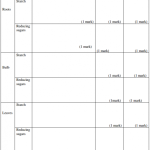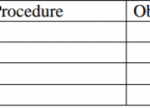KCSE Biology Paper 2 – Kabarak High School Mock 2015
Mock 2015 – Kabarak High School
Biology Paper 2
SECTION A (40 Marks)
Answer ALL questions
The diagram below indicates an organism that grows under shaded places with damp conditions. Study it and answer the questions that follow.
(a) Name the division to which the specimen belongs. (1 mark)
(b) Name and state the functions of the parts labelled Q, R and S. (6 marks)
Q
i) Name
ii) Function
R
i) Name
ii) Function
S
i) Name
ii) Function
(c) Name the two body forms of the organism in its alternation of generation.(2 marks)
9 marks
In cattle the gene for red colour is represented by letter R and that of white colour as W. A Red bull and a white cow were crossed and all the offspring were Roan.
(a) Give a reason for the appearance of roan cattle in F1 generation. (1 mark)
(b) Using a punnet square work out the F2 generation. (4 marks)
(c) State the genotypic and phenotypic ratio of the F2offspring above. (2 marks)
(d) Name the molecule that carries genetic information in eukaryotic cells. (1 mark)
8 marks
Study the diagram of the organism shown below then answer the questions that follow.
(a) State the phylum to which the organism belongs. (1mark)
(b) With reasons state the class to which the organism belongs.
i) Class (1 mark)
ii) Reasons (3 marks)
(c) Name two human diseases of which the organism is a vector. (2 marks)
(d) What type of metamorphis does the organism show? (1 mark)
8 marks
The epidermis of a leaf is adapted to have the specialized cells known as the guard cell such as shown below.
(a) (i) Name the structure labelled X on the diagram. (1 mark)
(ii) State three adaptations of the guard cell to its function of opening and closing of stomata in plants. (3 marks)
(b) The mammalian lung is known to have adapted the mammal to terrestrial habitat by having a pleural membrane.
(i) State two functions of a pleural membrane that gives the mammal advantage over other organisms. (2 marks)
(ii) Name two diseases of the respiratory system. (2 marks)
8 marks
The human ear has the following structures; (i) Auditory meatus
(ii) ear drum (iii) eustachian tube (iv) ear ossicles and (v) cochlea.
(a) Name two functions of the mammalian ear. (2 marks)
(b) For each of the structures above, state its function. (5 marks)
(i) Auditory meatus
(ii) Eardrum
(iii) Eustachian tube
(iv) Ear ossicles
(v) Cochlea
(c) Name a defect caused by damage of the cochlea. (1mark)
8 marks
SECTION B (40 Marks)
Answer question 6 (compulsory and either question 7 or 8 in the provided after question 8.
A physiologist working to determine the amount of glucose levels in the iliac artery and hepatic vein per hour after a heavy carbohydrate meal in mg/100ml of blood collected and recorded the following data in a 24 hour period. Study the data and use it to answer the questions that follow.
(a) On the same axes plot a line graph to show amount of glucose in mg/100ml of blood against time of the day in a 24hour day up to 4.00 p.m. (8 marks)
b) At what time of day was the amount of glucose the same in the iliac artery and iliac vein? (1 mark)
(c) Account for the rise in glucose levels in the iliac artery peaks at: (3 marks)
(i) 11.00 hrs a.m
(ii) 14:00 hrs p.m.
(d) Which organ and hormone is responsible for raising the sugar levels in Hepatic vein between 00.00 hrs – 2.00 hrs a.m. (2 marks)
i) Organ
ii) Hormone
(e) Name the hormone responsible for the fall of glucose and the complex polysaccharide that forms between 14:00 hrs p.m. and 6.00 hrs p.m. (2 marks)
i) Hormone
ii) Complex polysaccharide
(f) Name a disease that would have resulted if the hormone in (e) above failed to be produced. (2 marks)
18 marks
(a) Explain the role of the following factors in germination
(i) Oxygen (2marks)
(ii) Water (3 marks)
(iii) Gibberellic acid (1 mark)
(b) (i) Describe the various modes of adaptation for the flat worm of the blood Schistosoma mansonii (8 marks)
(ii) State the effects of Schistosoma mansonii on its primary host, the human (12 marks)
26 marks
(a) Describe how the digestion of a protein is achieved in the following portions of the alimentary canal.
(i) Stomach (4 marks)
(ii) Duodenum (4 marks)
(b) (i) Describe the process of absorption at the root hair to the xylem of the root. (8 marks)
(ii) Describe how temperature and light intensity affect the rate of transpiration. (4 marks)
20 marks













Thanks so much